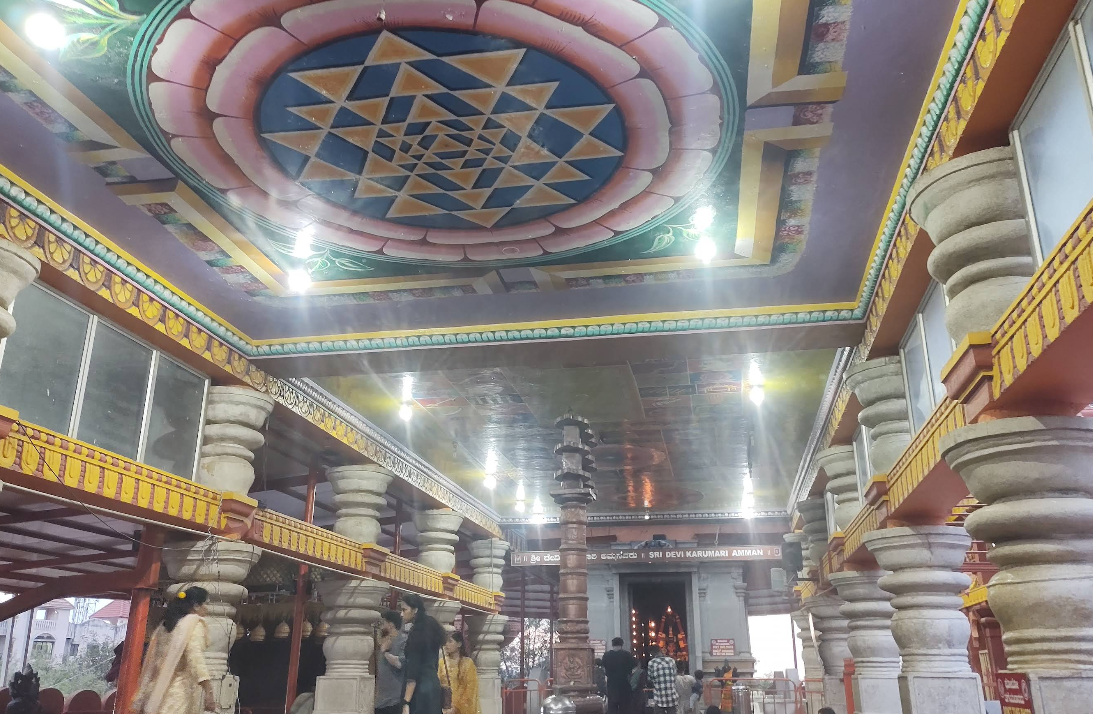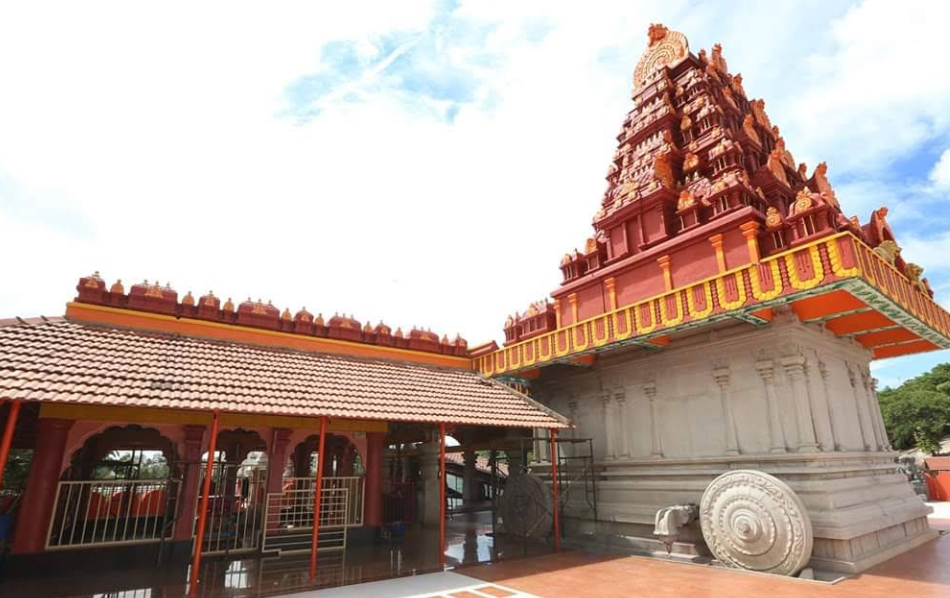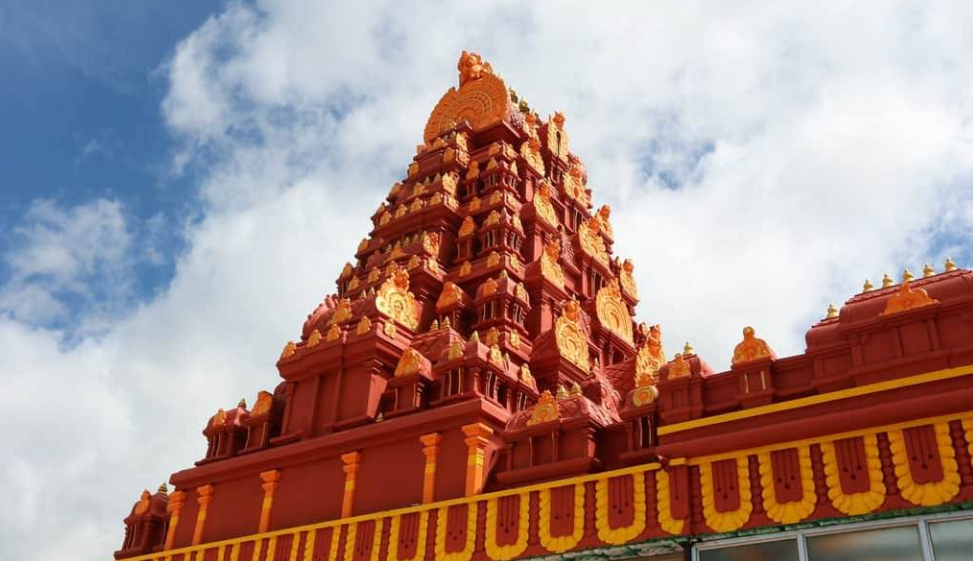A Sanctuary of Serene Power: Visiting the Shri Devi Karumariamma Thayi Temple Bengaluru
🖼️ Photo Gallery



🛕 Temple Info
Nestled in the serene locality of Rajarajeshwari Nagar in Bengaluru, Shri Devi Karumariamma Thayi Temple stands as a radiant abode of the Divine Mother. Located directly opposite to the famous Shrungagiri Shanmukha Swami Temple, this sacred shrine offers an equally divine experience for those seeking peace, devotion, and spiritual awakening.
What makes this temple architecturally unique is its structure — designed in the form of a traditional temple chariot (Ratha). Every intricate detail, from the sculpted wheels on the side walls to the carvings on the sanctum, reflects deep symbolism and artistic devotion. As you enter the premises, the calmness of the surroundings and the soft hum of prayers instantly instill a sense of tranquility.
The presiding deity, Goddess Karumariamma, is seated gracefully in a sitting posture, radiating a serene smile that seems to embrace every devotee with motherly affection. The idol is remarkably tall, beautifully adorned with flowers and ornaments, and exudes an aura of divine compassion. Many devotees describe their experience before the deity as “soul-soothing,” often finding themselves unable to take their eyes away from Her radiant form.
Adjacent to the main sanctum is a dhyana mandir or meditation hall, which also serves as a space for Satsangh meetings and community gatherings. The temple’s elevated location on a small hillock offers a panoramic view of Bengaluru city and the NICE Road below — especially enchanting during the early mornings or at sunset when the city glows under golden light. The temple remains spotlessly clean and well-maintained, providing a comfortable space for families, elderly devotees, and spiritual seekers alike.
Evenings here are particularly divine — as the lamps (Deepams) are lit and devotional songs like the “Jo Jo” song are sung during the Sayana Seva (putting the goddess to rest) around 8 PM. Visitors describe this as a surreal experience — the temple lights dim, the gentle sound of bells and hymns fill the air, and one can truly sense the goddess’s divine presence.
💫 Importance
Goddess Karumariamma is revered as a form of Mariamman, a powerful mother goddess deeply worshipped in South India, especially among Tamil-speaking communities. The name Mari in ancient Tamil means “Rain”, symbolizing abundance, fertility, and renewal, while Amman translates to “Mother”. Hence, Karumariamma is believed to be the divine bringer of rain, prosperity, and protection.
In traditional belief, she embodies the energies of Parvati, Durga, and Kali, representing compassion, strength, and destruction of evil. Devotees visit the temple to seek blessings for good health, protection from negative forces, and fulfillment of wishes. The goddess is often associated with the cycles of nature and life — worshipped for harmony, fertility, and cleansing of impurities both internal and external.
The Amavasya (New Moon) and Pournami (Full Moon) days are considered highly auspicious at this temple. On Amavasya, the temple witnesses large gatherings for Pratyangira Homa, a sacred fire ritual invoking divine protection and removal of obstacles. Such homas are common in Tamil culture and are performed with deep devotion here. Festivals like Aadi month celebrations, Navratri, and other Amman festivals are observed with grandeur, filled with folk dances, music, and rituals like fire-walking or offerings made in earthen pots such as Pongal and Koozh.
Devotees also speak of the unique vibration they feel within the temple — a sensation of peace and divine energy that lingers long after leaving the premises. The temple’s serene environment makes it not only a place of worship but also a refuge for meditation and inner reflection.
📜 History
While exact historical records are not detailed in the sources, the worship of Karumariamma traces its roots to ancient Tamil traditions of mother goddess worship — a practice believed to predate even the Vedic period. The temple itself, though modern in structure, carries forward these timeless traditions in its design, rituals, and energy.
Situated opposite to the Shrungagiri Shanmukha Swami Temple, this temple complements the spiritual landscape of Rajarajeshwari Nagar, forming a powerful divine triangle alongside nearby shrines like Arunachaleshwara Temple and Sri Lalitha Devi Temple. Devotees often visit all these temples as part of a spiritual circuit, experiencing different forms of Shakti and Shiva in one area.
Many visitors share heartfelt experiences of visiting the temple unexpectedly — often drawn by the sight of the glowing chariot-like structure or the peaceful chants from afar. Some recall moments of deep emotional connection, describing tears of devotion when they stood before the goddess. Despite its smaller scale compared to neighboring temples, its spiritual magnetism is immense, making it one of the hidden gems of Bengaluru’s sacred sites.
🪔 Pooja Timings
The temple is open daily for devotees:
- Morning: 8:00 AM to 11:30 AM
- Evening: 4:30 PM to 8:30 PM
The evening pooja at 6:00 PM is particularly special, when the lamps are lit and devotional songs create a deeply peaceful ambiance.
The Sayana Utsava (night ritual) held around 8:00 PM is another must-experience moment — a serene ceremony where the goddess is symbolically put to rest amidst divine lullabies.
On Amavasya, Pratyangira Homa is performed, drawing devotees from various parts of the city to seek blessings.
🚌 Transport Options
By Air:
The nearest airport is Kempegowda International Airport, Bengaluru (BLR), located about 50 km from Rajarajeshwari Nagar. From the airport, one can hire a cab or use airport shuttle services to reach the temple in approximately 1.5 hours.
By Rail:
The nearest major railway station is Krantivira Sangolli Rayanna (Bengaluru City Junction), around 12 km away. From the station, taxis and BMTC buses are available to reach Rajarajeshwari Nagar conveniently.
By Road:
Rajarajeshwari Nagar is well connected by BMTC city buses, autos, and private vehicles. The temple lies along the route leading to the NICE Road, making it easily accessible from various parts of Bengaluru, including Mysore Road, Kengeri, and Banashankari.
🏙️ Nearby Cities
Ramangar
Mandya
Tumakur
Mysore
Hosur
Hosakote
MytempleMypride Reflection
Shri Devi Karumariamma Thayi Temple is more than a place of worship — it is a divine expression of faith, artistry, and serenity. The chariot-shaped structure, the radiant smile of the goddess, and the rhythmic devotion of evening prayers create a space where divinity feels tangible. It embodies the timeless connection between nature, devotion, and motherhood, reminding every visitor that the Divine Mother listens, protects, and blesses unconditionally. This sacred site truly echoes the spirit of MyTempleMyPride — celebrating India’s living heritage, where ancient traditions meet heartfelt devotion in the modern world.